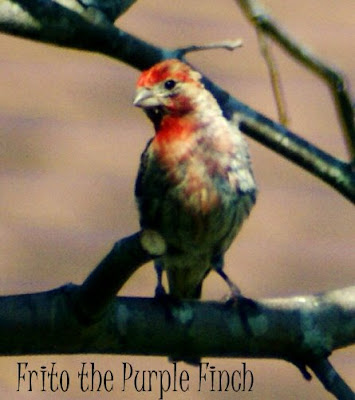Okay, here we go. At least there are pictures to keep you occupied during this post. It’s more for me to remember the neat animals I saw here, but I thought you guys might enjoy it, too.
This is a male purple finch named Frito. He visits quite often, and is semi-friendly to the other birds. Frito is a gorgeous bird, and is starting to get used to people watching him. Male purple finches can be identified by their colorful chest and head. Where they got the name ‘purple finches’ is a mystery to me because the chest, head, and back of the male finch are red, not purple. Anyway, the female purple finches are mainly gray and brown.
Angie and Jenny are both house sparrows, along with Sophie who was mentioned before. These birds are practically fearless when facing humans, and as long as we don’t venture to close, they will stay on the feeder during our talking. Both of these sparrows are females. The males have a black stripe that runs half-way down their chest, and auburn colored feathers rather than the grey and brown. They also have a grey patch on their heads.
I have a feeling these are fairly young sparrows. They have a younger look and are smaller next to the full grown sparrows who come by every once and a while.
This is Sheila and Sky. We don’t see much of Sky because he stays in the trees most of the time, which is how he got his name. He stays as close to the sky as possible!
I was very surprised one day when I opened the creaky door that scares every animal off and saw Sheila sitting in the tree staring at me. I had the pleasure of taking pictures of the pretty girl.
Sheila is a very cute squirrel, and she has a very unique way of getting her food. Because of the bird feeders size, the squirrels have a very hard time eating out of it. So Sheila finds her own way to get what she wants.
Step 1: She climbs onto the top of the feeder.
Step 2: Sheila leans as far over as she can without falling off, tipping the bird feeder so that seed falls out.
Step 3: She climbs down the tree and eats the fallen seeds.
All in all, I’ve been very pleased with the animals that I have seen eating out of the bird feeder. I love sitting out on the porch with a good book and watching the birds fly down and have a party in the tree, where I have hung the bird feeder.

















Sara
The birds are so colorful! i love the squirels because of their tails.
Sara
Anonymous
I really liked your blog! nice
Pingback: Kaitlynology